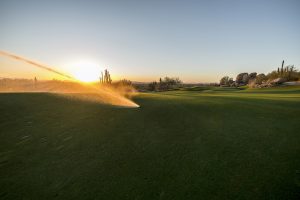Turf grass plants take up water via the root hairs at or near the tips of the roots. This then travels all the way up through the plant to the leaf – a very small amount of water is used by the plant for growth, the rest is transpired out of the plants pores. Water can also be lost from the site via evaporation from the leaf surface or soil below. The total amount of water usage by a plant is the evaporation, transpiration and that used for growth measured over time. So turf is a relatively low user for growth and water loss is normally measured in evapotranspiration, commonly known as ET. ET is expressed as a volume – mm or inches per day, week or month etc.
 Turf grass ET is affected by temperature, solar radiation, day length, wind, humidity and some other local environmental factors. The most important fact is that different species have different ET rates. This means that they all have a different point for survival, deficit and optimum performance. Across the world with warm and cool season grasses the difference can be drastic, but more locally there could well be a difference on a single site owing to the different grass types used on golf surfaces.
Turf grass ET is affected by temperature, solar radiation, day length, wind, humidity and some other local environmental factors. The most important fact is that different species have different ET rates. This means that they all have a different point for survival, deficit and optimum performance. Across the world with warm and cool season grasses the difference can be drastic, but more locally there could well be a difference on a single site owing to the different grass types used on golf surfaces.
All turf grass can be irrigated to achieve the different levels, understanding that at optimum levels plant growth will be efficient, maximum quality and turf grass appearance, while a deficit would promote less growth. This then enables the turf manager to decide how each of your surfaces are to be maintained. Using the example of a regular cool season grass golf club set up, the greens may well be maintained at 55-65% to lower growth but maintain plant health, ball speed and appearance, while the teeing grounds may be nearer 75-85% to ensure good growth habit to recover from play.
With optimum levels proactively maintained, inputs will be lower and playing conditions improved. Less water and electricity will be consumed and remedial works such as chemicals and cultural practices will be minimized. Rain Bird Central Control allows for the user to set a required water use deficit on each program, area and even every station if required. This allows the Central to accurately apply just the required amount proactively to deliver consistent turf and playing conditions. When directly linked to a Rain Bird weather station this can be done automatically delivering peace of mind and ease of use for the user. Simply tick the box and allow Rain Bird to look after the turf before course staff and the golfers even notice the requirements.
 In order to allow the Central to run in ET, your best option is to ensure accurate in field and Central setup. Inputting the data from the field including Spacing (shape type and distance), Rotor (Type and nozzle set up) flow rate and arc details allows the Central to have an accurate precipitation rate for the station. When in ET mode the Central will establish its own run times based on these precip rates and the ET % to be applied, so it’s vital the information is kept up to date when changes occur in the field. When not using ET to run the system the Central will reference a standard run time and this is often set to the max ET or volume that should be needed to be applied for a day. Again, inputting accurate precip data allows the standard runtime to be set correctly for each site. Standard run time references leave the decisions up to the user which can give more control but also allow for enhanced chances of peaks and troughs in turf and playing conditions due to reactive irrigation.
In order to allow the Central to run in ET, your best option is to ensure accurate in field and Central setup. Inputting the data from the field including Spacing (shape type and distance), Rotor (Type and nozzle set up) flow rate and arc details allows the Central to have an accurate precipitation rate for the station. When in ET mode the Central will establish its own run times based on these precip rates and the ET % to be applied, so it’s vital the information is kept up to date when changes occur in the field. When not using ET to run the system the Central will reference a standard run time and this is often set to the max ET or volume that should be needed to be applied for a day. Again, inputting accurate precip data allows the standard runtime to be set correctly for each site. Standard run time references leave the decisions up to the user which can give more control but also allow for enhanced chances of peaks and troughs in turf and playing conditions due to reactive irrigation.
Rain Bird Central Control allows for a user to utilize a combination of both, which often gives the best results and ease of use for our customers. Setting all areas bar the greens to work for ET is a practice often used to allow the turf manager to focus daily attention and data reading to the greens, knowing the Central Control is looking after the rest in real time.
ET control and reporting is available to all Rain Bird Central Control users including Stratus LT, Stratus 2, Nimbus 2 and Cirrus.
Click HERE to watch a how-to video on setting up your Central to use ET.

